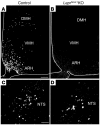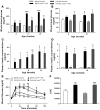Disruption of hypothalamic leptin signaling in mice leads to early-onset obesity, but physiological adaptations in mature animals stabilize adiposity levels
- PMID: 20592471
- PMCID: PMC2912188
- DOI: 10.1172/JCI41985
Disruption of hypothalamic leptin signaling in mice leads to early-onset obesity, but physiological adaptations in mature animals stabilize adiposity levels
Abstract
Distinct populations of leptin-sensing neurons in the hypothalamus, midbrain, and brainstem contribute to the regulation of energy homeostasis. To assess the requirement for leptin signaling in the hypothalamus, we crossed mice with a floxed leptin receptor allele (Leprfl) to mice transgenic for Nkx2.1-Cre, which drives Cre expression in the hypothalamus and not in more caudal brain regions, generating LeprNkx2.1KO mice. From weaning, LeprNkx2.1KO mice exhibited phenotypes similar to those observed in mice with global loss of leptin signaling (Leprdb/db mice), including increased weight gain and adiposity, hyperphagia, cold intolerance, and insulin resistance. However, after 8 weeks of age, LeprNkx2.1KO mice maintained stable adiposity levels, whereas the body fat percentage of Leprdb/db animals continued to escalate. The divergence in the adiposity phenotypes of Leprdb/db and LeprNkx2.1KO mice with age was concomitant with increased rates of linear growth and energy expenditure in LeprNkx2.1KO mice. These data suggest that remaining leptin signals in LeprNkx2.1KO mice mediate physiological adaptations that prevent the escalation of the adiposity phenotype in adult mice. The persistence of severe adiposity in LeprNkx2.1KO mice, however, suggests that compensatory actions of circuits regulating growth and energy expenditure are not sufficient to reverse obesity established at an early age.
Figures








Similar articles
-
Specific physiological roles for signal transducer and activator of transcription 3 in leptin receptor-expressing neurons.Mol Endocrinol. 2008 Mar;22(3):751-9. doi: 10.1210/me.2007-0389. Epub 2007 Dec 20. Mol Endocrinol. 2008. PMID: 18096691 Free PMC article.
-
Distinct networks of leptin- and insulin-sensing neurons regulate thermogenic responses to nutritional and cold challenges.Diabetes. 2015 Jan;64(1):137-46. doi: 10.2337/db14-0567. Epub 2014 Aug 14. Diabetes. 2015. PMID: 25125486 Free PMC article.
-
LRP1 regulates food intake and energy balance in GABAergic neurons independently of leptin action.Am J Physiol Endocrinol Metab. 2021 Feb 1;320(2):E379-E389. doi: 10.1152/ajpendo.00399.2020. Epub 2020 Dec 28. Am J Physiol Endocrinol Metab. 2021. PMID: 33356995 Free PMC article.
-
Changes in the neuroendocrine control of energy homeostasis by adiposity signals during aging.Exp Gerontol. 2009 Jan-Feb;44(1-2):20-5. doi: 10.1016/j.exger.2008.05.005. Epub 2008 May 20. Exp Gerontol. 2009. PMID: 18572339 Review.
-
Leptin signaling, adiposity, and energy balance.Ann N Y Acad Sci. 2002 Jun;967:379-88. doi: 10.1111/j.1749-6632.2002.tb04293.x. Ann N Y Acad Sci. 2002. PMID: 12079865 Review.
Cited by
-
Ablation of the leptin receptor in myeloid cells impairs pulmonary clearance of Streptococcus pneumoniae and alveolar macrophage bactericidal function.Am J Physiol Lung Cell Mol Physiol. 2018 Jul 1;315(1):L78-L86. doi: 10.1152/ajplung.00447.2017. Epub 2018 Mar 22. Am J Physiol Lung Cell Mol Physiol. 2018. PMID: 29565180 Free PMC article.
-
Central insulin signaling modulates hypothalamus-pituitary-adrenal axis responsiveness.Mol Metab. 2014 Dec 10;4(2):83-92. doi: 10.1016/j.molmet.2014.12.001. eCollection 2015 Feb. Mol Metab. 2014. PMID: 25685696 Free PMC article.
-
Structure, production and signaling of leptin.Metabolism. 2015 Jan;64(1):13-23. doi: 10.1016/j.metabol.2014.09.010. Epub 2014 Sep 28. Metabolism. 2015. PMID: 25305050 Free PMC article. Review.
-
Molecular Imprints of Clinical Comorbidities in Hypothalamic Extracellular Vesicles at the Onset of Obesity.ACS Omega. 2025 May 29;10(22):23563-23581. doi: 10.1021/acsomega.5c02274. eCollection 2025 Jun 10. ACS Omega. 2025. PMID: 40521556 Free PMC article.
-
Notch/Rbpjκ signaling regulates progenitor maintenance and differentiation of hypothalamic arcuate neurons.Development. 2013 Sep;140(17):3511-21. doi: 10.1242/dev.098681. Epub 2013 Jul 24. Development. 2013. PMID: 23884446 Free PMC article.
References
Publication types
MeSH terms
Substances
Grants and funding
LinkOut - more resources
Full Text Sources
Medical
Molecular Biology Databases
Miscellaneous

